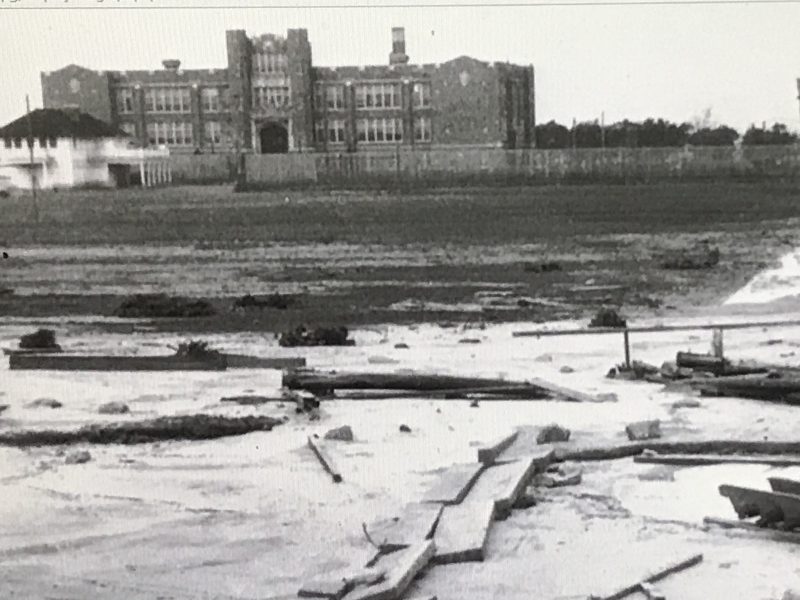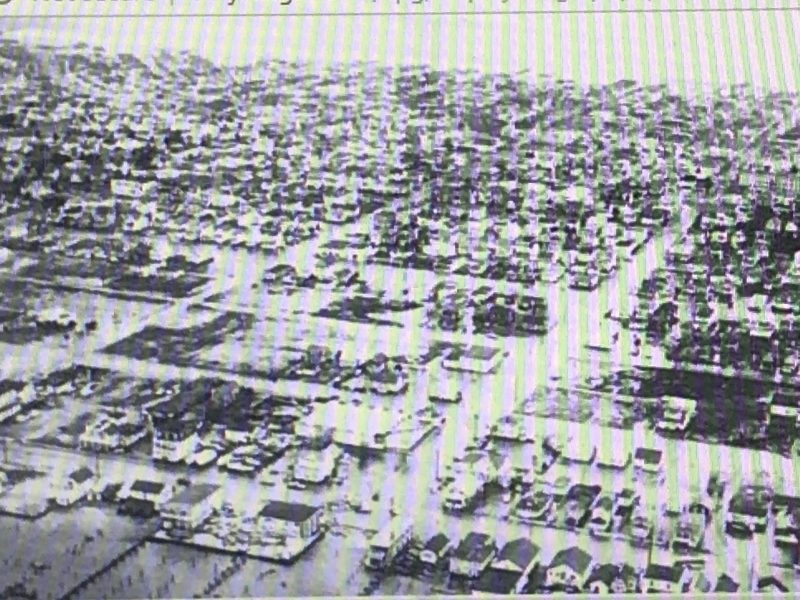Hundreds of Ocean City houses were destroyed and thousands of others were damaged by the 1944 Great Atlantic Hurricane. (Photos courtesy of ocnjimages.com)
 By TIM KELLY
“It was one hell of a blow,” John Loeper said of what became known as the “Great Atlantic Hurricane” of 1944, which tore through Ocean City 75 years ago this Friday
Loeper, president of the board of directors of the Ocean City Historical Museum, was less than two years old at the time. Though a bit young to actually remember the hurricane, Loeper could imagine what it must’ve been like.
“Ocean City was awash,” he said, referring to the bay meeting the ocean and a miles-long path of destruction in between. “The entire town was underwater.”
In the era before hurricanes were given human names, what the media would dub the “Great Atlantic Hurricane” carved out its own niche as Ocean City’s first “superstorm.”
“Ocean City had never ever seen anything like it before,” local historian Fred Miller said, “and Ocean City wouldn’t see anything like it again until the ‘March Storm’ of 1962.”
The hurricane, described in different published reports as a category 3 or a category 4 storm, packed sustained winds of 75 miles per hour and gusts in excess of 100 miles per hour for approximately four hours.
Wednesday, Sept. 13, 1944, dawned as an extremely humid day, reports said, but gave no hint as to what was to come.
“There was no TV at the time and radio reports were wrong,” Miller said of forecasts predicting landfall in the Carolinas and stating the hurricane’s path would take it more than 100 miles out to sea when it traveled past Ocean City.
Further distraction from the advancing storm resulted from the fact the United States was still in the throes of World War II.
“People were more worried about reports that German U-boats were prowling the seas off Ocean City than weather reports,” Loeper said.
Around mid-day, the rain began to fall and the wind picked up.
“Then all hell broke loose,” an eyewitness said, according to the Associated Press.
By TIM KELLY
“It was one hell of a blow,” John Loeper said of what became known as the “Great Atlantic Hurricane” of 1944, which tore through Ocean City 75 years ago this Friday
Loeper, president of the board of directors of the Ocean City Historical Museum, was less than two years old at the time. Though a bit young to actually remember the hurricane, Loeper could imagine what it must’ve been like.
“Ocean City was awash,” he said, referring to the bay meeting the ocean and a miles-long path of destruction in between. “The entire town was underwater.”
In the era before hurricanes were given human names, what the media would dub the “Great Atlantic Hurricane” carved out its own niche as Ocean City’s first “superstorm.”
“Ocean City had never ever seen anything like it before,” local historian Fred Miller said, “and Ocean City wouldn’t see anything like it again until the ‘March Storm’ of 1962.”
The hurricane, described in different published reports as a category 3 or a category 4 storm, packed sustained winds of 75 miles per hour and gusts in excess of 100 miles per hour for approximately four hours.
Wednesday, Sept. 13, 1944, dawned as an extremely humid day, reports said, but gave no hint as to what was to come.
“There was no TV at the time and radio reports were wrong,” Miller said of forecasts predicting landfall in the Carolinas and stating the hurricane’s path would take it more than 100 miles out to sea when it traveled past Ocean City.
Further distraction from the advancing storm resulted from the fact the United States was still in the throes of World War II.
“People were more worried about reports that German U-boats were prowling the seas off Ocean City than weather reports,” Loeper said.
Around mid-day, the rain began to fall and the wind picked up.
“Then all hell broke loose,” an eyewitness said, according to the Associated Press.

 At Fifth Street, just a few planks and scattered debris remain where the Boardwalk was. In the background is the old Ocean City High School.
According to the National Oceanic and Atmospheric Administration, the storm produced some of the highest water levels ever seen and recorded in the state. Reports claimed that some waves were more than 30 feet high off local beaches.
In typical Ocean City fashion, the town responded to protect its citizens and property. Miller said police, fire and Beach Patrol personnel all assisted in removing stranded people from their flooded homes and ushering them to safety.
“People who evacuated their homes or who lost them were sheltered at City Hall,” he said.
He noted that the American Red Cross was on hand to aid victims, as was a cadre of volunteers from the town.
The next day at low tide, Ocean City officials and residents were finally able to survey the extent of the damage, estimated to be almost $400 million when adjusted for inflation to 2019 dollars.
“There was still another miracle to come, the town’s recovery from the hurricane,” Miller asserted.
“It seemed like everyone worked together to get things back in order before the start of the 1945 summer tourism season,” he said.
Yet it would take years for some homes and businesses to be rebuilt and some never would be, he added.
“That didn’t stop Ocean City, which recovered nicely and quickly,” Miller said. “By the time the summer season of 1945 arrived, there were very few visible scars from the storm.”
Today, three quarters of a century later, the Great Atlantic Hurricane is still remembered and discussed as one of the most impactful weather events in Ocean City history.
At Fifth Street, just a few planks and scattered debris remain where the Boardwalk was. In the background is the old Ocean City High School.
According to the National Oceanic and Atmospheric Administration, the storm produced some of the highest water levels ever seen and recorded in the state. Reports claimed that some waves were more than 30 feet high off local beaches.
In typical Ocean City fashion, the town responded to protect its citizens and property. Miller said police, fire and Beach Patrol personnel all assisted in removing stranded people from their flooded homes and ushering them to safety.
“People who evacuated their homes or who lost them were sheltered at City Hall,” he said.
He noted that the American Red Cross was on hand to aid victims, as was a cadre of volunteers from the town.
The next day at low tide, Ocean City officials and residents were finally able to survey the extent of the damage, estimated to be almost $400 million when adjusted for inflation to 2019 dollars.
“There was still another miracle to come, the town’s recovery from the hurricane,” Miller asserted.
“It seemed like everyone worked together to get things back in order before the start of the 1945 summer tourism season,” he said.
Yet it would take years for some homes and businesses to be rebuilt and some never would be, he added.
“That didn’t stop Ocean City, which recovered nicely and quickly,” Miller said. “By the time the summer season of 1945 arrived, there were very few visible scars from the storm.”
Today, three quarters of a century later, the Great Atlantic Hurricane is still remembered and discussed as one of the most impactful weather events in Ocean City history.
 “Ocean City was awash,” Historical Museum Board President John Loeper said. “The entire island was underwater.”
“Ocean City was awash,” Historical Museum Board President John Loeper said. “The entire island was underwater.”